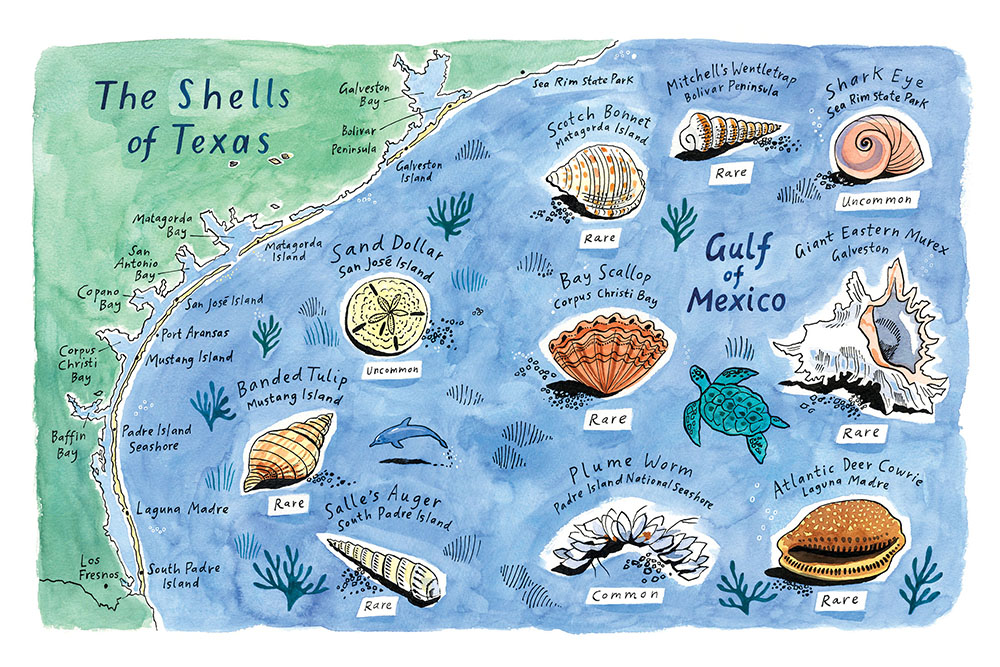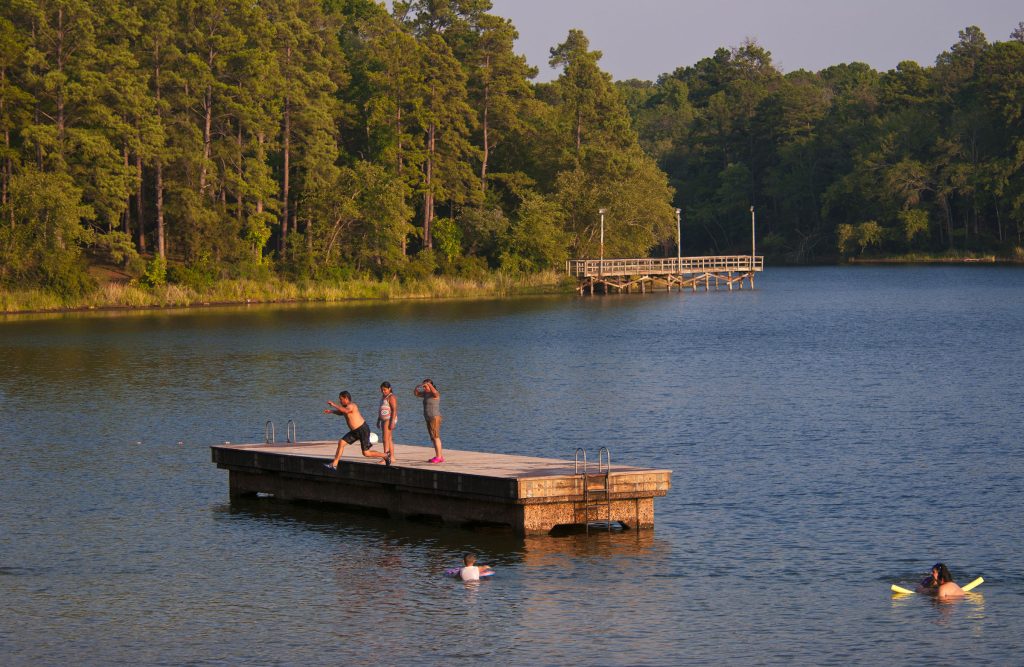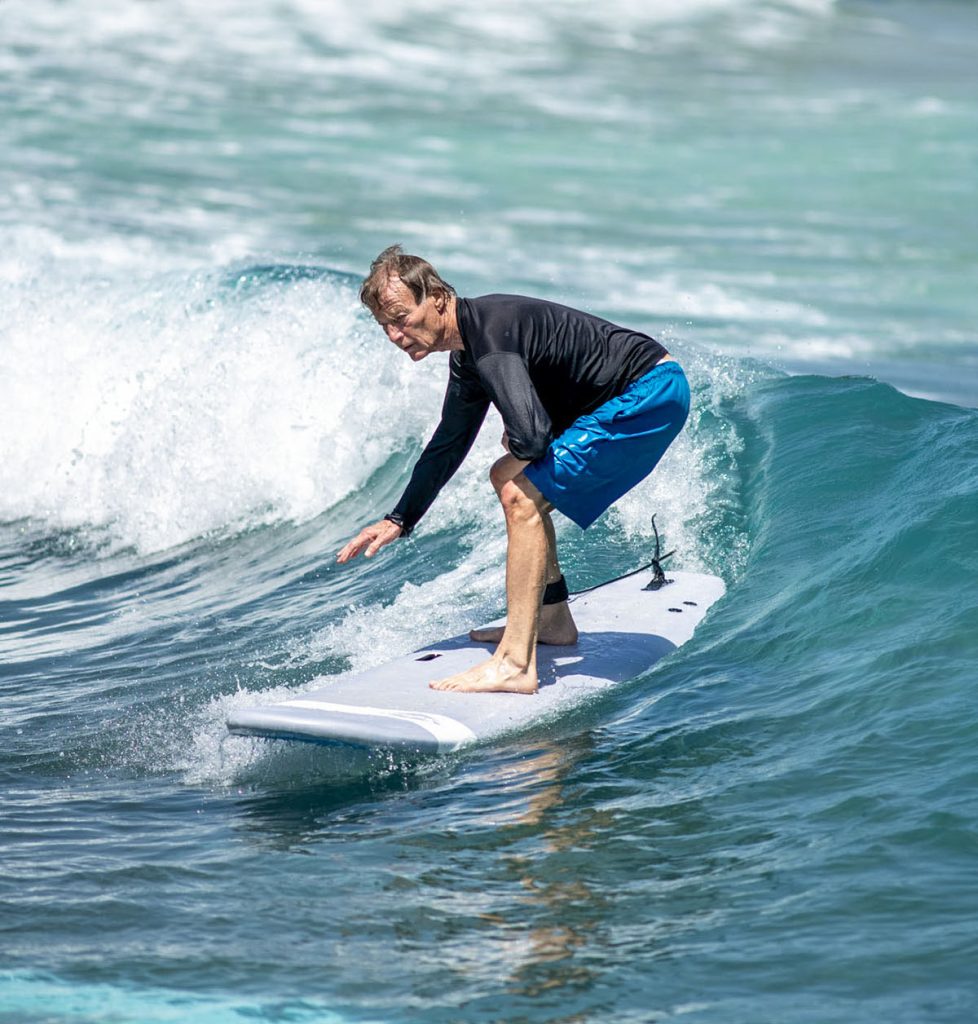Gifts from the ocean become gifts for humanity on the beaches of Padre Island
A collection of shells from South Padre Island.
Somewhere in Texas the moon is shining, but not tonight, not in South Padre. A pitch-black night has engulfed the barrier island, blurring the Gulf Coast surf, sand, and sky into a shapeless void. The floodlights from high-rise resorts lining the beachfront offer only the suggestion of a great blue heron standing one-legged in the water, still as a sentry, angling for a midnight snack. An early December breeze carries the smell of salt and the sound of crashing waves. This is a time of rest and recuperation for the folks who call this tourist town home. In just a few months, these dark, deserted beaches will be cluttered with spring break partiers. So, as the locals hunker down for winter, the cloaked moon works double-time, turning the tide shoreward and back, revealing all the sea has seen.
At daybreak, a pink sun crests the horizon as Kristen Faine, dressed in a loose T-shirt, yoga pants, and sandals, strikes out across the beach. Her long, thin shadow parses the distance between the shoreline and the vine-choked sand dunes that serve as the beach’s backdrop. Two more shadows lag behind hers but with wagging tails. There’s Nyssa, a 6-year-old Yorkie, and Sweetie, an 11-year-old teacup poodle. The sand underfoot is studded with seashells of all shapes, sizes, and colors—some still scuttling around on tiny legs—mixed with bits of plastic, rope, and other flotsam and jetsam.
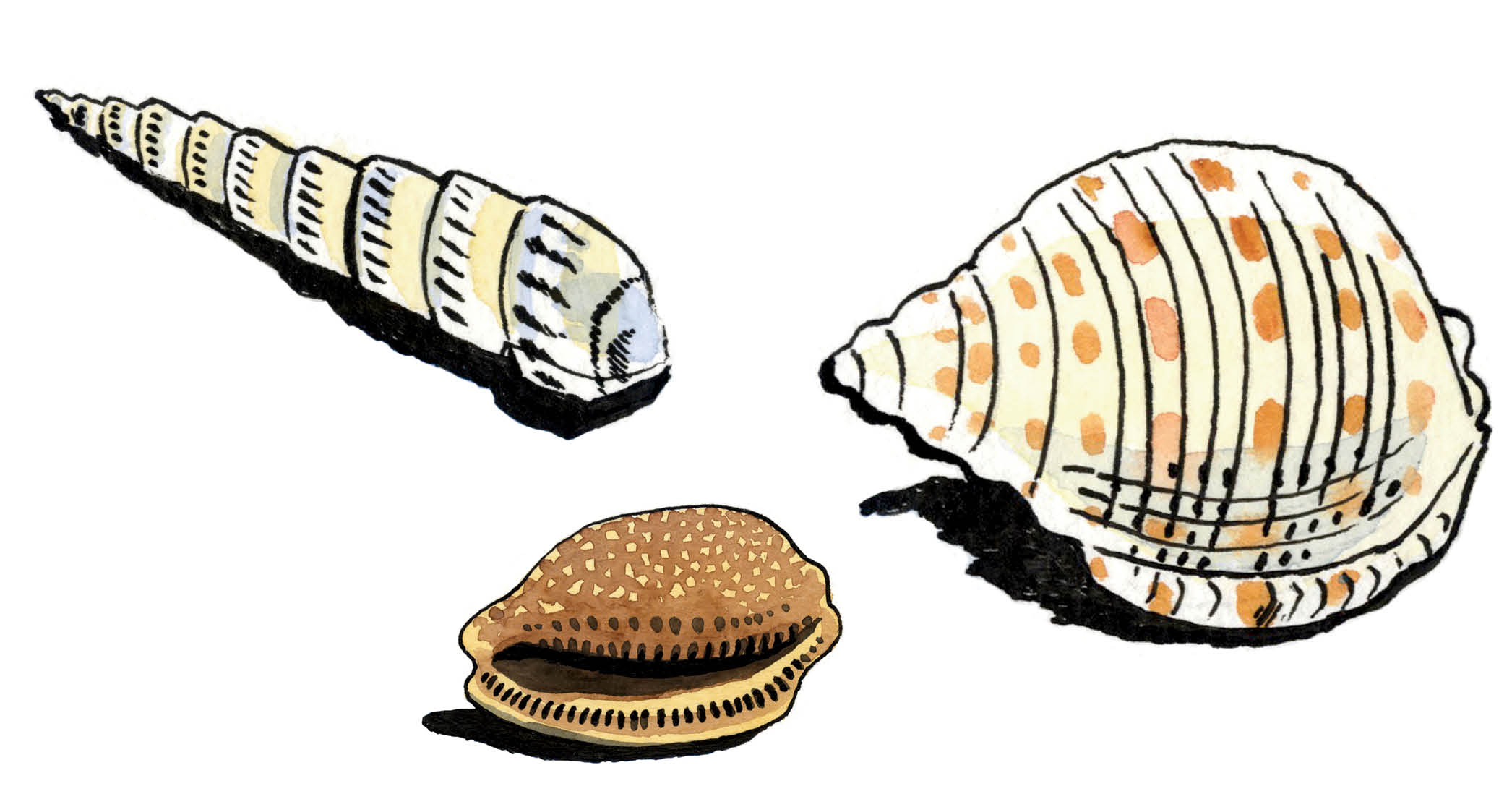
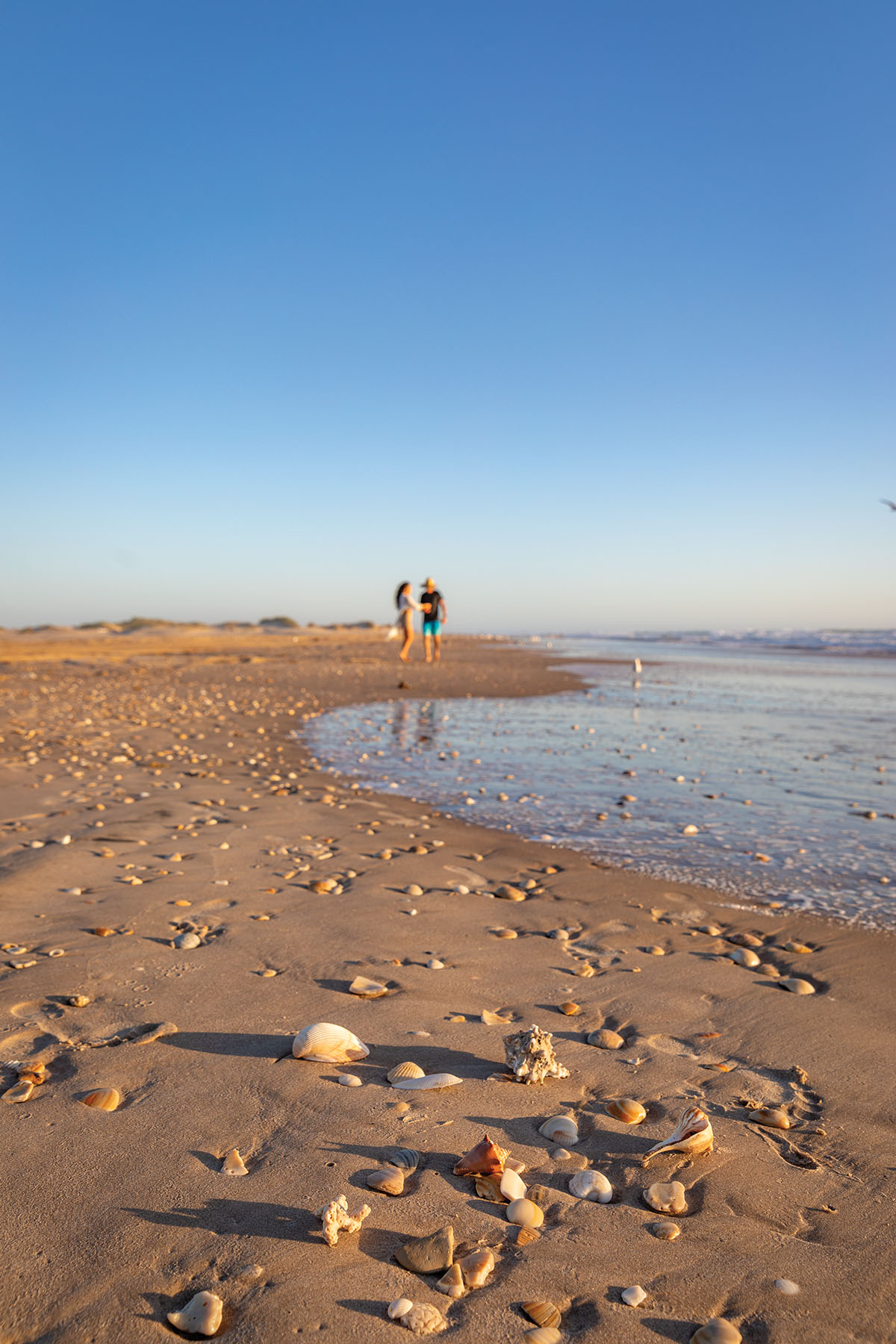
Beachcombing at PINS
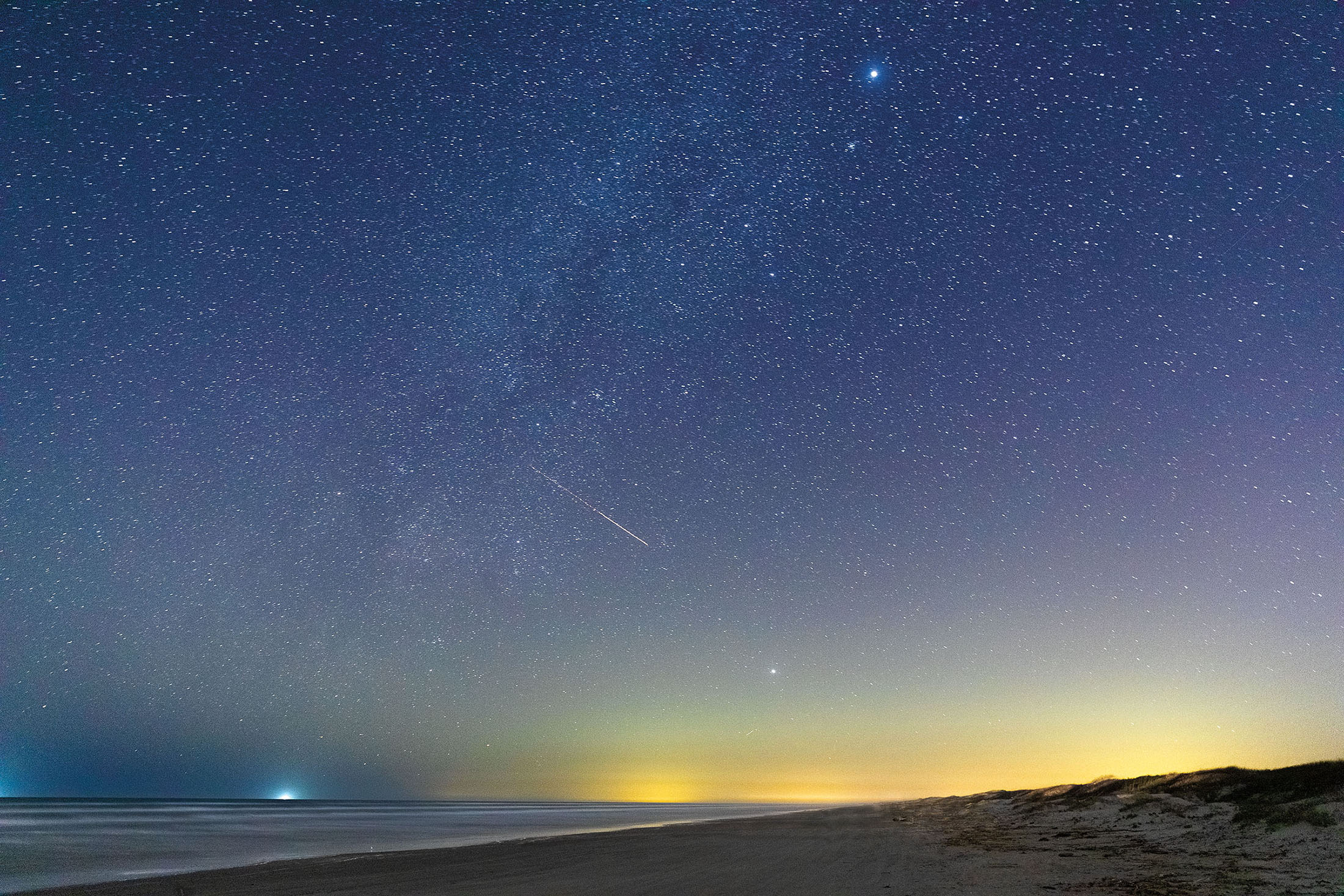
Night falls at the Padre Island National Seashore.
Faine suddenly stops walking. She bends over and plucks a seashell from the ground. “Oh, I found a sundial!” she says, cupping the pecan-size shell in her palm. Sundials are inlaid with hypnotic, swirling patterns that make them popular with shell enthusiasts like Faine. This shell formerly housed a carnivorous sea snail; now it’s coming home with her. She deposits it in a green plastic bag, the same kind you’d use to pick up after your pet. Nyssa rolls on her back in the wet surf, showing no interest in the sundial; Sweetie, the more polite of the pair, gives it a perfunctory sniff.
This is a world away from Faine’s native Ohio, where she had a long career working in prisons. Now she finds herself on South Padre Island once a year. Each November, she and her husband, Jerry, travel to Texas in a black-and-white motorcoach, ending up at Isla Blanca RV Park near the jetties at the southern tip of the island. Jerry’s still in the RV this morning, boldly sleeping past 7 a.m. But Faine is compelled to shell. She’s up before dawn several times a week to walk the beach, pups in tow, and peruse the items the ocean coughed up overnight.
Faine is one of many shellers who haunt the beaches of South Padre each morning to find new specimens to add to their collections. It’s a perennial pastime in Texas. The state claims 367 miles of coastline and three regions for the activity: primarily South Padre Island but also Corpus Christi and Galveston. The majority of seashells are washed-up exoskeletons of mollusks, a large and diverse group including oysters, scallops, snails, conchs, squid, and octopuses. Mollusks are the second largest phylum of the animal kingdom, second only to insects, with over 100,000 species. Shellers can find close to 1,000 species on Texas beaches, along with shark teeth, arrowheads, gold coins, and a zillion other items.
But shells have become scarcer on some beaches in recent decades, the result of human encroachment and overcollecting, according to Texas Seashells: A Field Guide (2014). Collectors have adopted the “sheller’s creed”: Take only what you need, and don’t leave any litter behind.
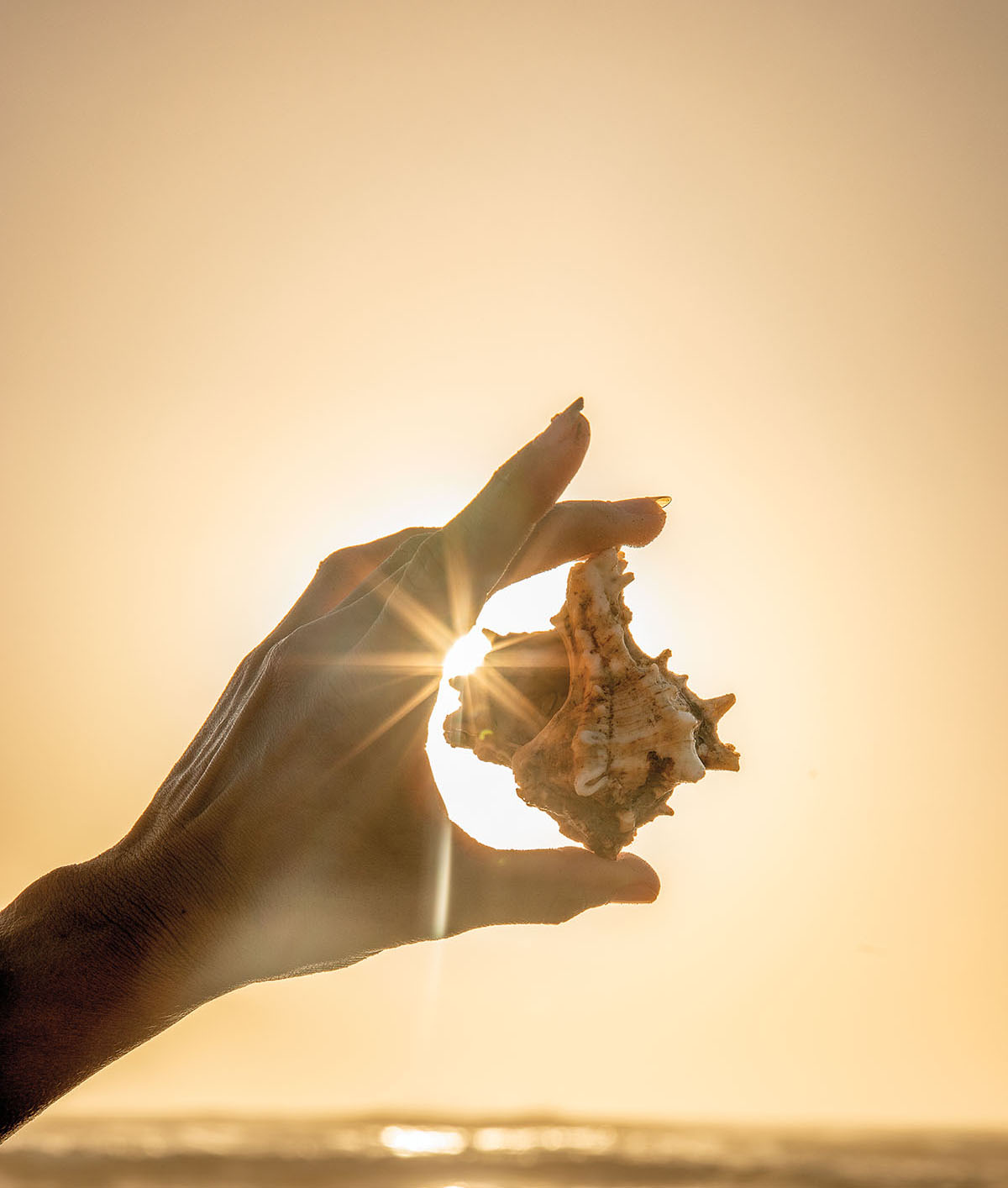
A sheller shows off a giant eastern murex.
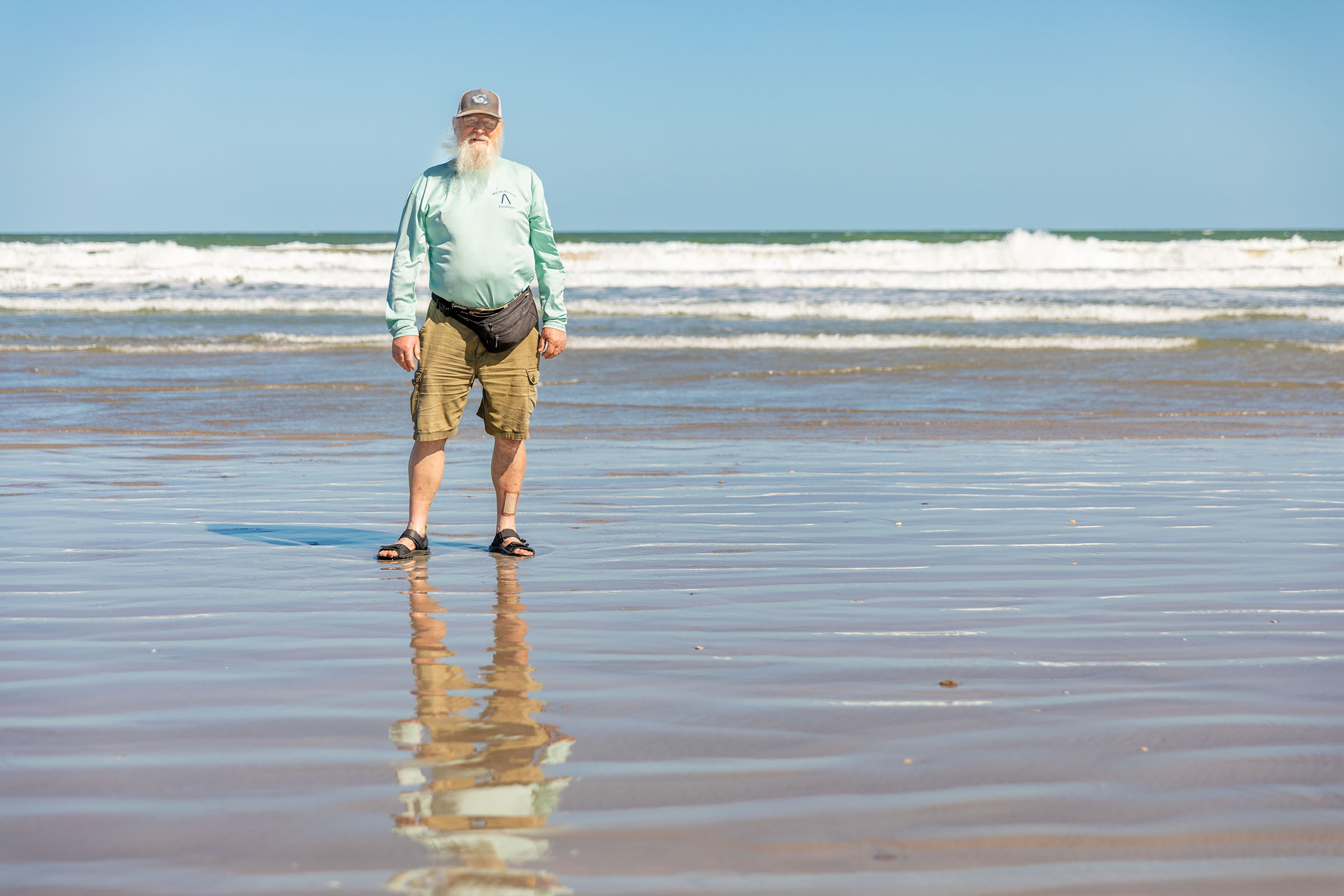
Philip Woods leads tours of Malaquite Beach.
Winter is the best time for shelling. The beaches are emptier, and powerful, low-pressure fronts can whip the waves into a frenzy, churning up the ocean bottom and laying its bounty on land. “The next day you’ll see massive—I’m talking massive—amounts of shells. They come up this high,” Faine says, pointing halfway up her shin. “When there’s a big dump, you see people going zoom, zoom, zoom. I mean, as fast as they can!”
There’s no big dump today, but Faine scores anyway. In addition to the sundial, she finds a lettered olive, a coral, half of a blue crab, a shark eye snail, and several purple barnacles. She’s always on the look for sand dollars, prized seashells that are hard to find intact. Another shell collector crosses our path. Faine asks if she’s spotted any. “I didn’t find a sand dollar, but I found some change,” the woman says, palming the broken remains of a couple of critters.
In five years, Faine has amassed a considerable collection. She and Jerry elevate her best finds into art they create together. There’s an alligator made from interlocking oyster shells, a forest display with a piece of wave-carved driftwood as the centerpiece, and an owl with coquina shells for ears. Mostly she gives away the shells and arrangements to friends back home. A neighborhood kid once used Faine’s shells to build an arrangement for his mother. “Is that not cool? I was just tickled,” Faine says. The remainder of her shell inventory sits in neat piles on a plastic folding table next to the motorcoach.
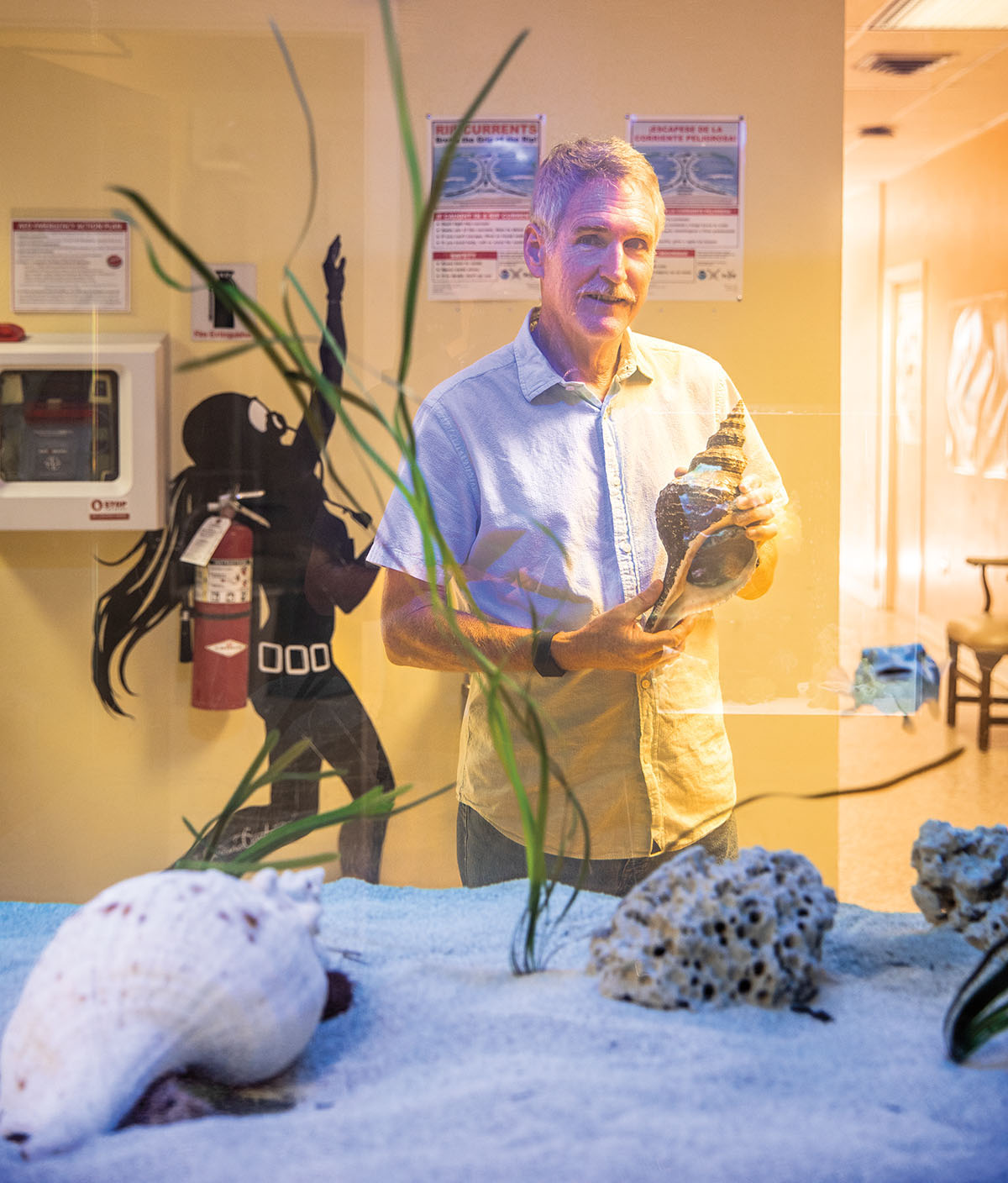
David Hicks holds a Florida horse conch at the Coastal Studies Laboratory.
An even more impressive array of seashells is on display just a few hundred feet away at the Coastal Studies Laboratory. The lab, which is operated by the University of Texas Rio Grande Valley, conducts beach surveys and water-quality sampling as part of the Texas Beach Watch program. It also functions as a quasi-museum, giving viewers a glance at some of the state’s most spectacular shells—a few still attached to their bodies. Inside the lab’s aquarium, a Florida horse conch carries a footlong shell on its back as it scoots across the bottom of a fish tank. It sports a pair of chubby pink antennae and resembles a wad of rolling bubblegum. It’s the largest gastropod in U.S. waters, weighing on average 11 pounds.
The laboratory is directed by David Hicks, a professor of marine and coastal sciences at UTRGV. He’s spent his life studying the mollusks responsible for making seashells. The quest has taken him well beneath the surface of the sea—up to 350 feet deep and 50 miles offshore, where reefs hold rare species. “I’ve run the gamut from knee-deep to offshore,” Hicks says. “I think I have a hunched back because I spend so much time walking and looking at the ground.”
Though the shelling is stellar on South Padre’s gulf shoreline, some of the professor’s favorite mollusks are found in the Laguna Madre, a saltwater lagoon that separates South Padre from mainland Texas. The waterway is home to several species of mollusks that are specially adapted to thrive here, where the average water depth is one meter and a seagrass meadow carpets the floor.
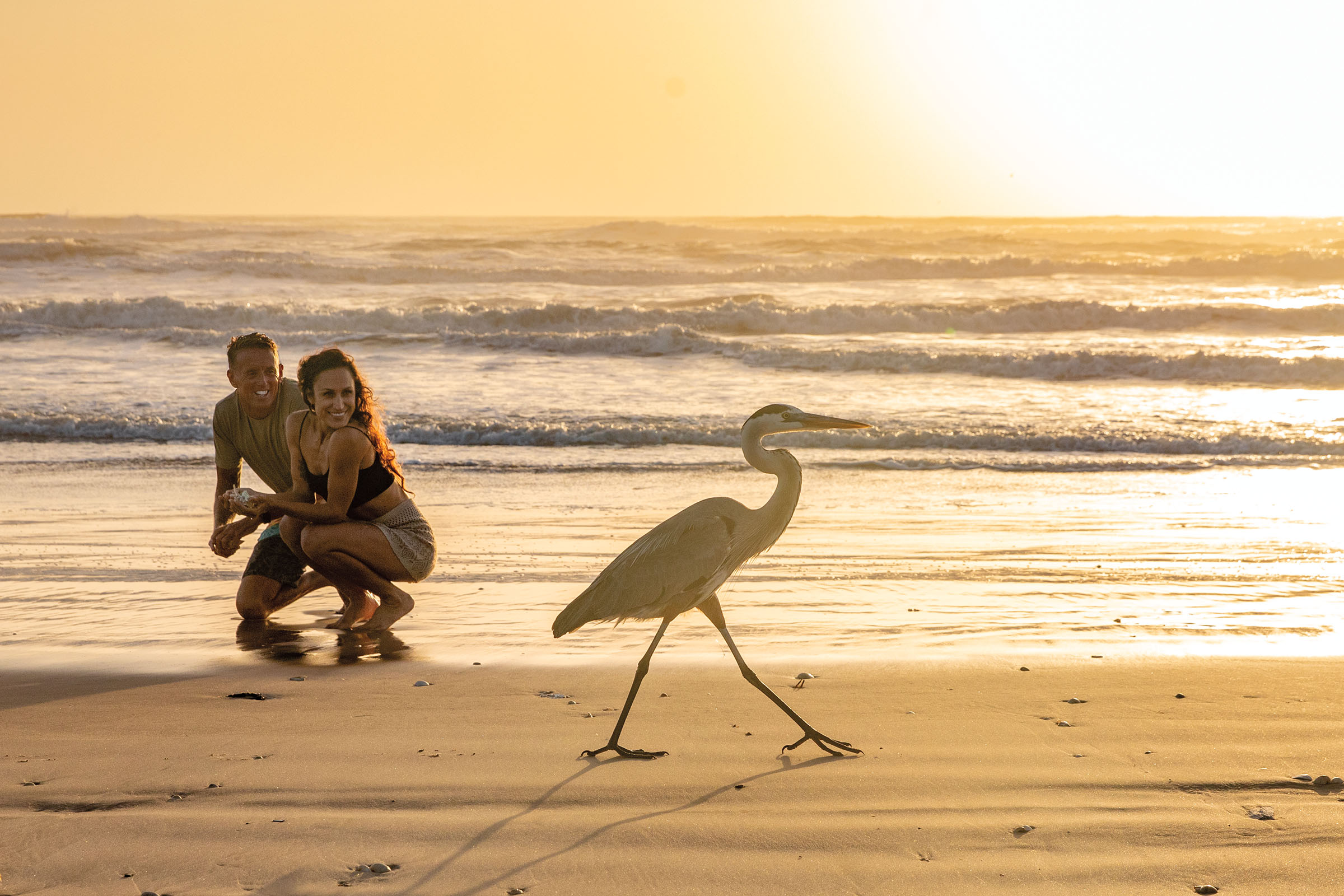
Beachcombers admire a great blue heron
The bay scallop, which Hicks considers “the most interesting and conspicuous” mollusk in these grass beds, can swim short distances by rapidly clapping its shell valves together. The small bivalves make a sumptuous post-beach meal once collected en masse and slathered in butter. Then there’s the grass cerith, an arrowhead-shaped mollusk that grazes exclusively on epiphytes, microalgae that occupy blades of seagrass by the millions. Larger critters, such as fiddler crabs, pick off the grass ceriths, and redfish and trout come for the crabs. “Mollusks form important linkages that make the complex food chain possible,” Hicks says.
In fact, mollusks are so important here that their influence extends past the food web and into the everyday lives of humans. At any given moment, they’re being plucked from the beach, or served on the half-shell with a lemon wedge, or ground up and spread across the road to fill potholes. The mollusks of South Padre Island are omnipresent. And they’ve been that way for a long time up and down the coast, way before Europeans arrived on the scene. “They’ve been used as religious symbols, and of course there’s food—the oysters in Texas were a staple of Karankawa Indians,” Hicks says. “Man and mollusk have been in step since the beginning of time.”
Anthropologist Dirk Van Tuerenhout calls it “time immemorial.” That’s about 20,000 years ago, when evidence indicates early humans began using shells from the Gulf of Mexico, according to Tuerenhout, the curator of anthropology at the Houston Museum of Natural Science. “The people who lived on the coast would collect clams and marine food resources all the way along the Gulf Coast,” he says. As time went on, humans found more inventive ways to use shells: to make tools, for use in burial rites, as currency, and in construction. Some tribes even built entire islands, or heightened existing islands, by using millions of shells to increase their elevation above sea level.
The Karankawa are probably the best-known tribe of the Gulf Coast, but others have occupied the space, too, such as the Coahuiltecan, Akokisa, and Atakapa peoples. For thousands of years, Natives harvested shellfish in an intercontinental arc from the Mayan cities of Central America, through Texas, and along the gulf shoreline into Florida. The shells they left behind help researchers track the movement of early people. In one case, a cache of Texas lightning whelk shells was found at an archeological dig site in St. Louis, more than 1,000 miles away. “There’s evidence of all of that happening for quite a long time,” Tuerenhout says. “It’s an ongoing tradition, going back thousands of years.”
Shells have historically lent themselves to artwork, too. Researchers have found painted shells that predate recorded history, along with shell carvings that depict the places and events of an ancient world. The tradition of carving continues today at the museum, where Tuerenhout oversees an exhibit on Indigenous people, featuring shell art produced by living Indigenous artists. One piece depicts a creation story told through images carved around the perimeter of a shell using a Dremel tool. Each night the shell is turned slightly to reveal another chapter of the story. It’s a reminder that seashells are still potent cultural symbols in the modern world.
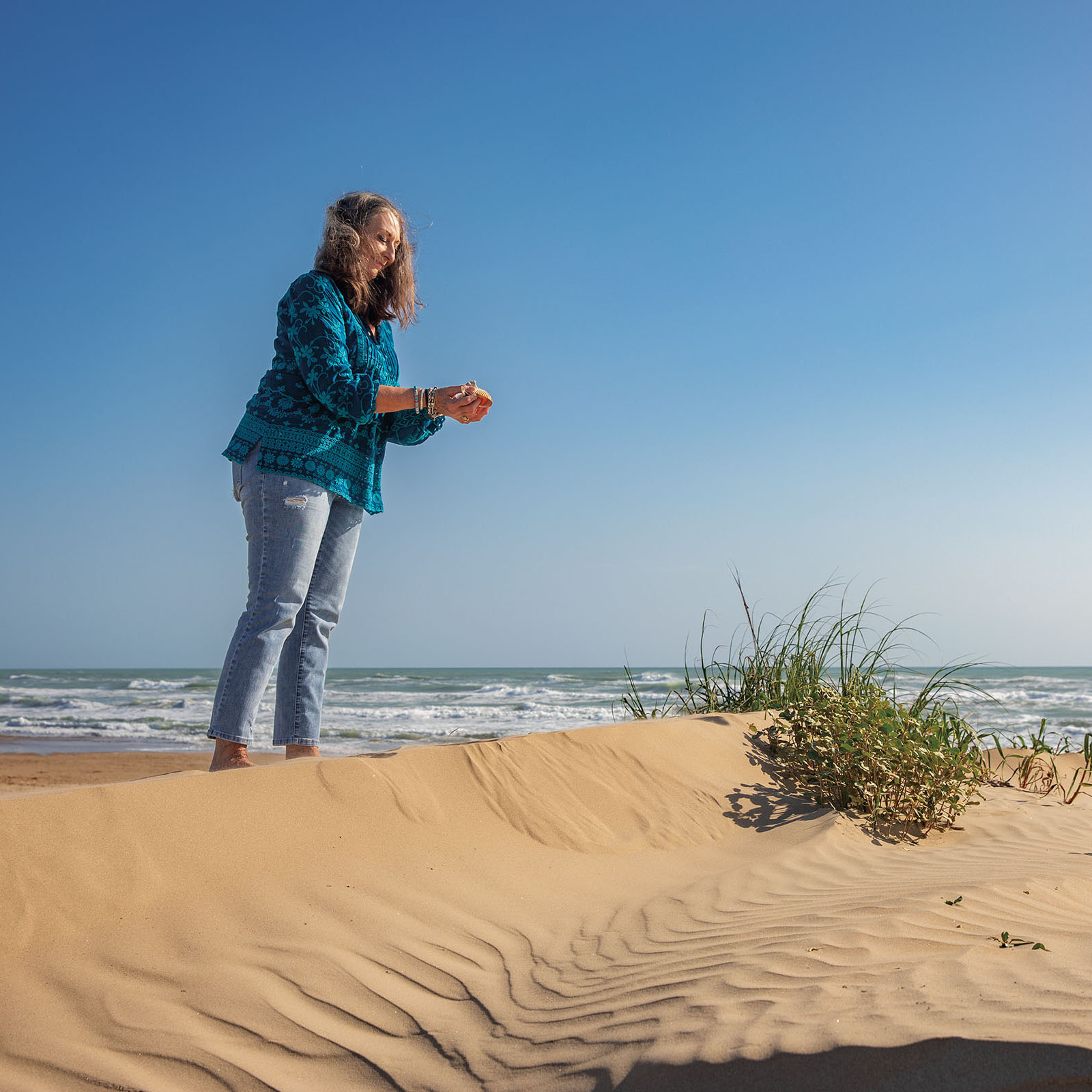
Pam Bradley of the Port Isabel-South Padre Island Shell Club
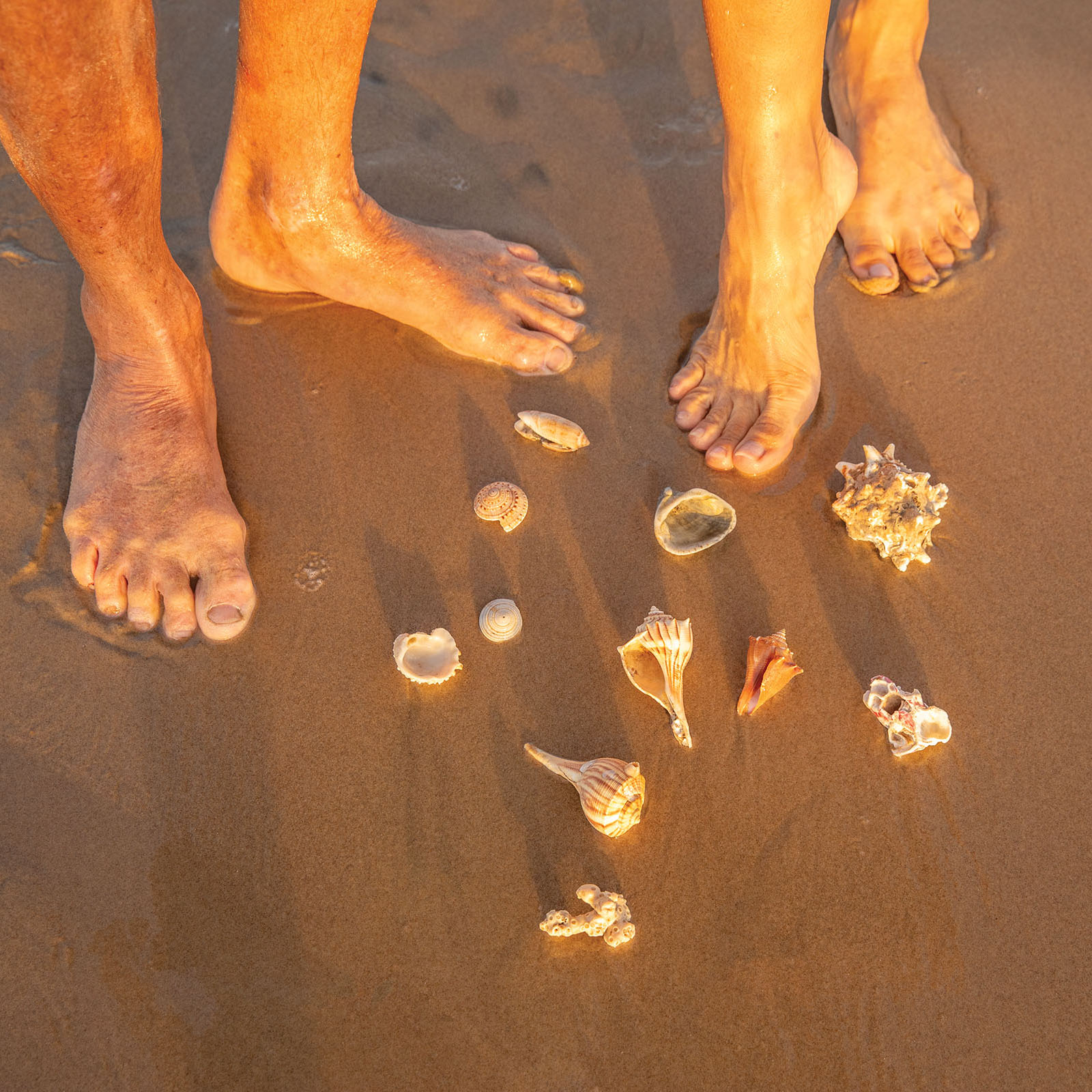
If you can’t make it to the beach—or clingy sand isn’t your thing—you can still score shells at a souvenir shop. In Port Isabel, just across the causeway from the island, Bay Quest has everything from flip-flops to hermit crabs looking for forever homes. The store’s entrance doubles as the gaping maw of a killer whale. Inside, novelty T-shirts paper the walls up to the ceiling.
Ayla Fima has been a Bay Quest employee for three years. She likes the job and clientele, who are usually easygoing. She says she’s gotten a feeling for why customers buy shells—usually they’re getting them for someone else. “You know, like a souvenir you take home as a gift,” she says. Fima used to make jewelry out of the shells she collected. Now she braids hair with shells at the store.
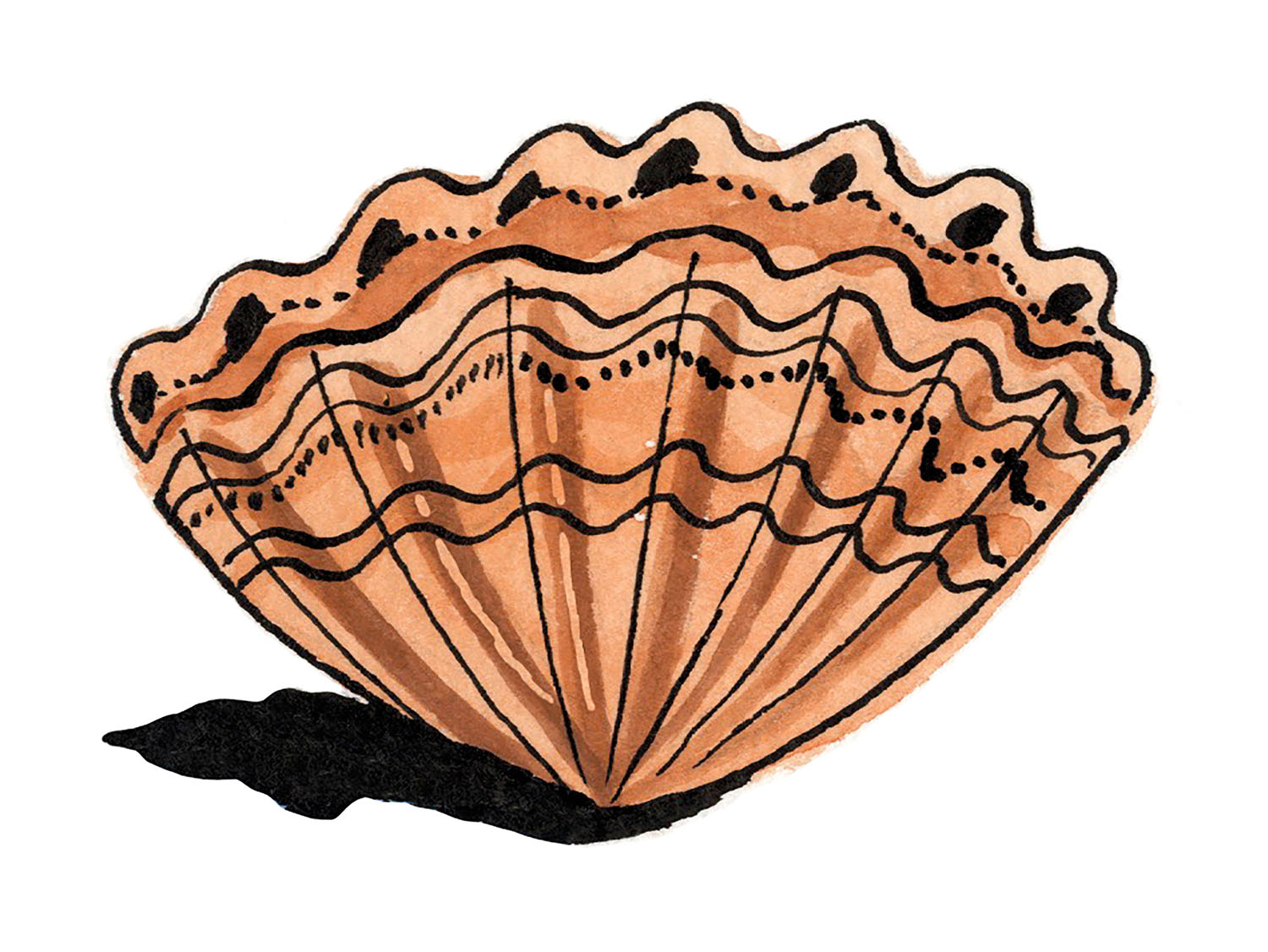
It’s a recurring theme in the shelling community: The act of giving a shell is as important as collecting it. Pam Bradley, president of the Port Isabel-South Padre Island Shell Club, has a habit of giving out shells. It makes her feel good, she says. “I’ve given shells to people who I’ve met and talked with on the beach. Other people have given me shells,” Bradley says. “I’m not real sure why; it’s just a gift of the sea that you’re sharing.” But sometimes an exchange goes awry. “One time I gave a little girl—she was about 2—this beautiful sundial. I was talking to her mother, and the girl threw it right back in the water. I was like, ‘Note to self: Don’t give a sundial to a 2-year-old.’”
A couple hours north, past an inhospitable stretch of shifting sand and towering dunes, resides another seashell mecca of the Texas coast: Padre Island National Seashore. It’s just across the bridge from Corpus Christi, past the gas stations and burger joints on the southern edge of town. The national seashore offers 66 miles of undeveloped beaches and natural habitat. It has the benefit of being located where two converging longshore currents meet, funneling a smorgasbord of ocean material to the area.
This is easy to observe at Big Shell Beach, near the seashore’s midpoint, where massive drifts of shells intermittently wash up. Much of it is shell hash—or pulverized and fragmented shells that are of little interest to collectors—but there’s still a boatload of intact specimens to find here. The pickings at Big Shell are even better thanks to sparse foot traffic in the area. The beach lies about 20 miles from any paved road, so prospective collectors need to secure a four-wheel-drive vehicle to make the trek.
More accessible is Malaquite Beach, which sits on the gulf side of the seashore at the foot of a campground and visitors center. It’s the park’s most popular beach, named for a tribe of Coahuiltecan Native Americans known as Malaquitas. The 4.5 miles of beach are closed to vehicles, making it ideal for shell collecting. On this weekday morning, the crowd is small. That’s to the advantage of Janet Tokar and Stephanae Arnett, who are on vacation from Central Texas and on the lookout for shells.
The women have different aims but make a good team. Tokar is a collector, eager to add new shells to her fairy garden back home in a small town south of San Antonio. Arnett, of nearby Pipe Creek, enjoys spotting the shells but has little interest in bringing them home with her. There’s plenty to see on the beach today, and Arnett’s eyes don’t miss much. In a swath of seafoam, she discerns a palm-size starfish whose body blends so effectively with its surroundings that it’s practically invisible. She sees a coconut, bashed open with four of its seeds spilled onto the sand—except upon closer inspection, one of the seeds is just a very dirty golf ball.
“Good eye!” Tokar says to her friend. “See, that’s what happens when you’re walking fast. You miss treasures.” For Tokar, anything that catches her eye qualifies as treasure. She’ll pick up broken or common shells that other beachcombers tend to ignore, if she likes their looks. “I’m not a purist,” she says. Sometimes she’ll look for shells with holes in them because they’re good for making necklaces and other jewelry. She keeps some simply out of habit, something she’s done since childhood. “I have so many. They’re tied to memories,” she says.
Volunteers inside the park’s visitors center stand by to help collectors identify their finds. Today the task falls to Philip Woods, an upbeat volunteer with a long gray beard and a small day pack. Visitors hand Woods their shells and he spreads them over a plastic countertop, reeling off exotic names and obscure trivia in staccato fashion. There’s the usual stuff: arc shells, shark eye snails, lightning whelks. Some items are more curious, such as dried hunks of tar, the product of oil seeps on the ocean floor, and sea beans, plant seeds that can float for thousands of miles before finding a suitable place to take root. The most common are the seeds of the black mangrove tree, a native of Bermuda. “The deer love those things,” Woods says. “Once we start getting a lot on the beaches, the deer will really be down there eating.”
Woods leads educational beach walks once a day. He relishes introducing visitors to the weirdest stuff that washes up on Malaquite Beach. One such oddity is the plume worm, a tube worm that reinforces the outside of its tube with fragments of broken shells, giving it the impression of an armored sock. Today their empty tubes have washed up by the tens of thousands—all the worms have been slurped out by a flurry of hungry wildlife. Another of Woods’ strange favorites is the whip coral, made of slender, fluorescent yellow threads that are easily mistaken for a length of discarded fishing line. The resemblance is so striking that a well-intentioned man is hard at work on the beach today, picking up heaping armfuls of the coral and throwing it into a garbage bag.
But Woods doesn’t receive everything that washes ashore with joy. There are plenty of disheartening finds, too, such as the shells of red-eared sliders, freshwater turtles that infrequently are found dead, and the petrified bodies of thousands of pufferfish that washed ashore during winter storm Uri in February 2021. He’s found the vertebrae of a dolphin and occasional plastic water bottles bearing the bite marks of sea turtles. A box inside the visitors center holds these items, reminding beachgoers that some of their favorite marine critters face an uncertain future. Displays like this teach the public about the environmental challenges facing the Texas coast and beyond.
No surprise, Woods likes to share his shells. For me, it’s a sand dollar, obtained from his sister, who had collected too many and was planning to throw them out. He’s taken to building shadow boxes to make use of excess shells. Bradley, the president of the shell club, took a similar approach, handing out bags of seashells to attendees of an Earth Day event in Los Fresnos. Along with thinning her glut of shells at home, the giveaway spread the message of conservation. “People just love to get stuff like that,” she says. “They were like little kids—even the adults.”
On Padre Island, the appeal of seashells is universal and everlasting. As long as the moon continues to rise over Texas each night, stirring the Gulf Coast soup, they will be swept from their world to ours, waiting to be witnessed when the darkness breaks.
